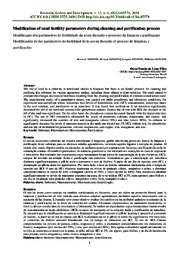Modification of sand fertility parameters during cleaning and purification process
Modification of sand fertility parameters during cleaning and purification process
Author(s): LIMA FILHO, O. F. de
Summary: Resumo: O uso da areia como substrato em estudos nutricionais é frequente, porém não há um protocolo formal de limpeza e purificação desse substrato para os diversos estudos agronômicos, incluindo aqueles ligados à nutrição de plantas. O estudo teve como objetivo avaliar as alterações de atributos químicos resultantes da limpeza e purificação da areia de construção comum. O estudo experimental, de natureza quantitativa, foi realizado em condições de casa de vegetação e laboratório. Foi realizado um experimento cujos tratamentos foram níveis de concentração de ácido clorídrico (HCl), tempos de imersão na solução ácida e purificação em autoclave. Constatou-se que a esterilização em autoclave diminuiu significativamente o pH da areia e aumentou o teor de fósforo. A partir de um dia de repouso com HCl, a diminuição no pH da areia foi significativa. Por outro lado, o teor de fósforo aumentou linearmente com o tempo de imersão em HCl. O uso de HCl eliminou totalmente os níveis de potássio, cálcio, magnésio e cobre, e diminuiu consideravelmente os teores de ferro e manganês (acima de 70%) e zinco (acima de 80%). Para exaurir ou diminuir significativamente os níveis de nutrientes presentes na areia, deve-se utilizar HCl a 3%, sem repouso, para fósforo e um dia de incubação para potássio, cálcio, magnésio e cobre, ferro, manganês e zinco. Abstract: The use of sand as a substrate in nutritional studies is frequent, but there is no formal protocol for cleaning and purifying this substrate for various agronomic studies, including those related to plant nutrition. The study aimed to evaluate the changes in chemical attributes resulting from the cleaning and purification of common construction sand. The experimental study, of a quantitative nature, was carried out under greenhouse and laboratory conditions. An experiment was carried out whose treatments were levels of hydrochloric acid (HCl) concentration, immersion times in the acid solution, and purification in an autoclave. It was found that sterilization in an autoclave significantly decreased the pH of the sand and increased the phosphorus content. From a day of rest with HCl, the decrease in the pH of the sand was significant. On the other hand, the phosphorus content increased linearly with the immersion time in HCl. The use of HCl completely eliminated the levels of potassium, calcium, magnesium, and copper, and significantly decreased the contents of iron and manganese (above 70%) and zinc (above 80%). To exhaust or significantly decrease the levels of nutrients present in the sand, one should use 3% HCl, without rest, for phosphorus and one day of incubation for potassium, calcium, magnesium, and copper, iron, manganese, and zinc.
Publication year: 2024
Types of publication: Journal article
Unit: Embrapa Vegetables
Keywords: Esterilização, Nutriente, Substrato de Cultura
Observation
Some of Embrapa's publications are published as ePub files. To read them, use or download one of the following free software options to your computer or mobile device. Android: Google Play Books; IOS: iBooks; Windows and Linux: Calibre.
Access other publications
Access the Agricultural Research Database (BDPA) to consult Embrapa's full library collection and records.
Visit Embrapa Bookstore to purchase books and other publications sold by Embrapa.

